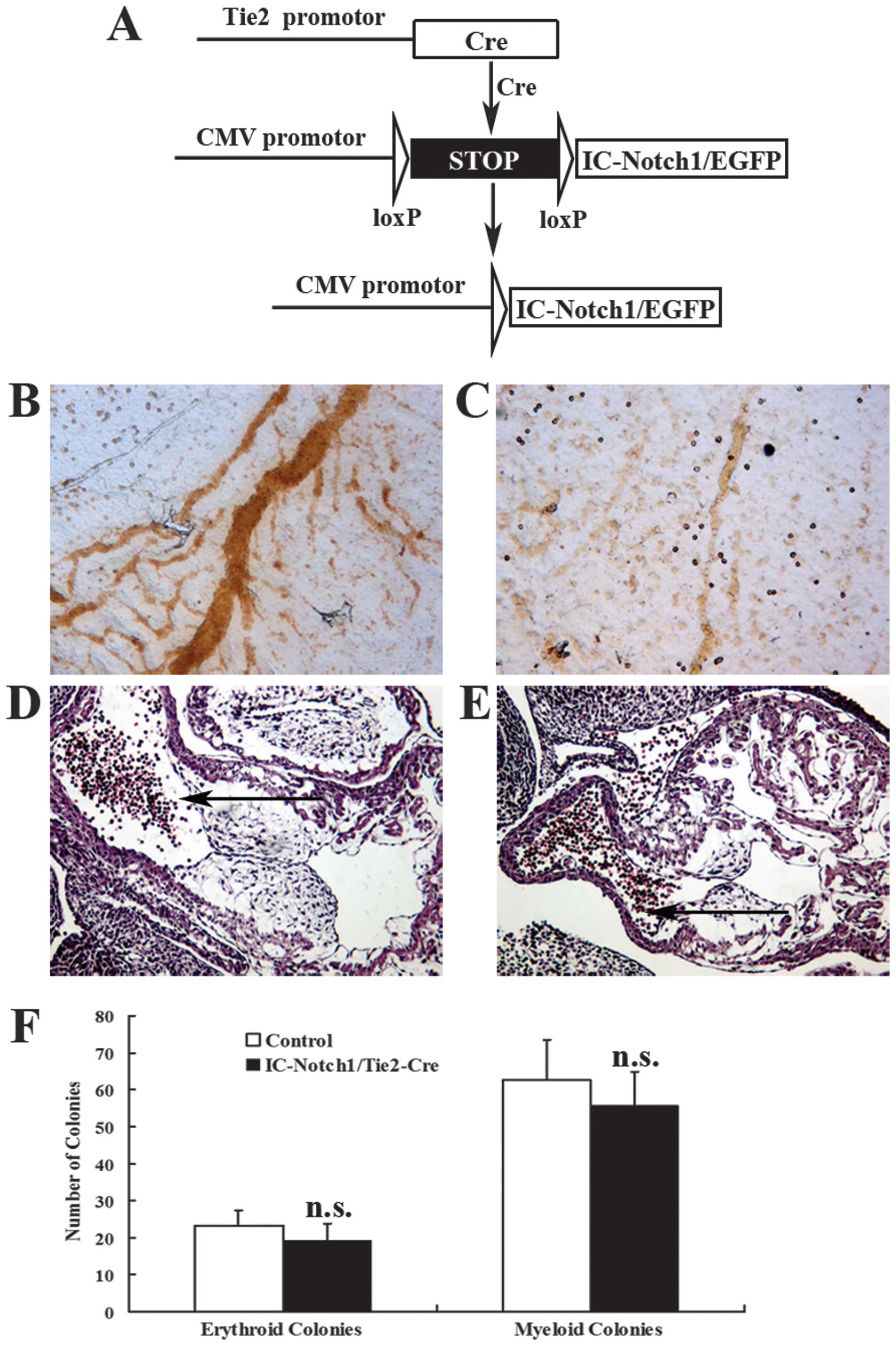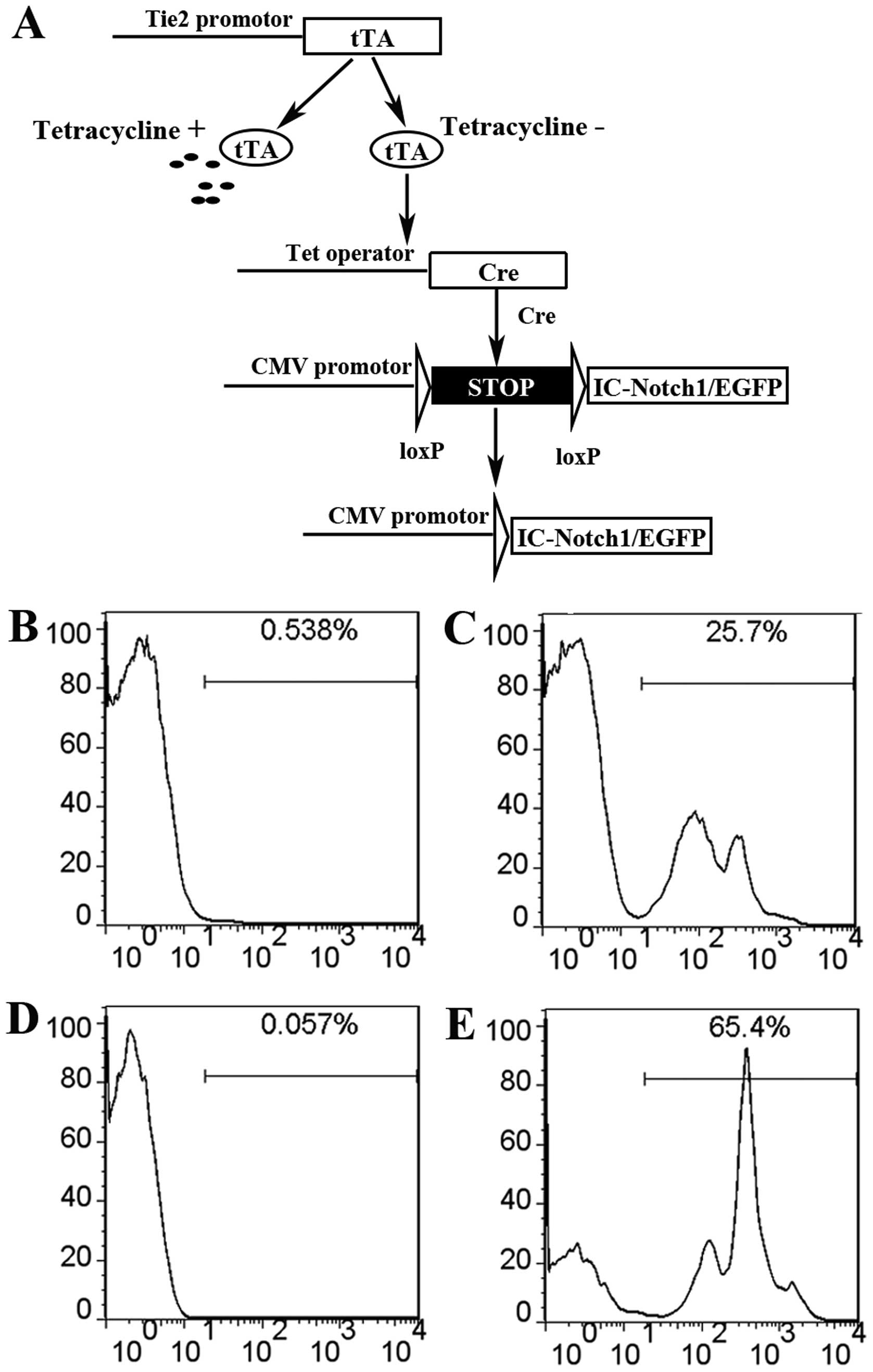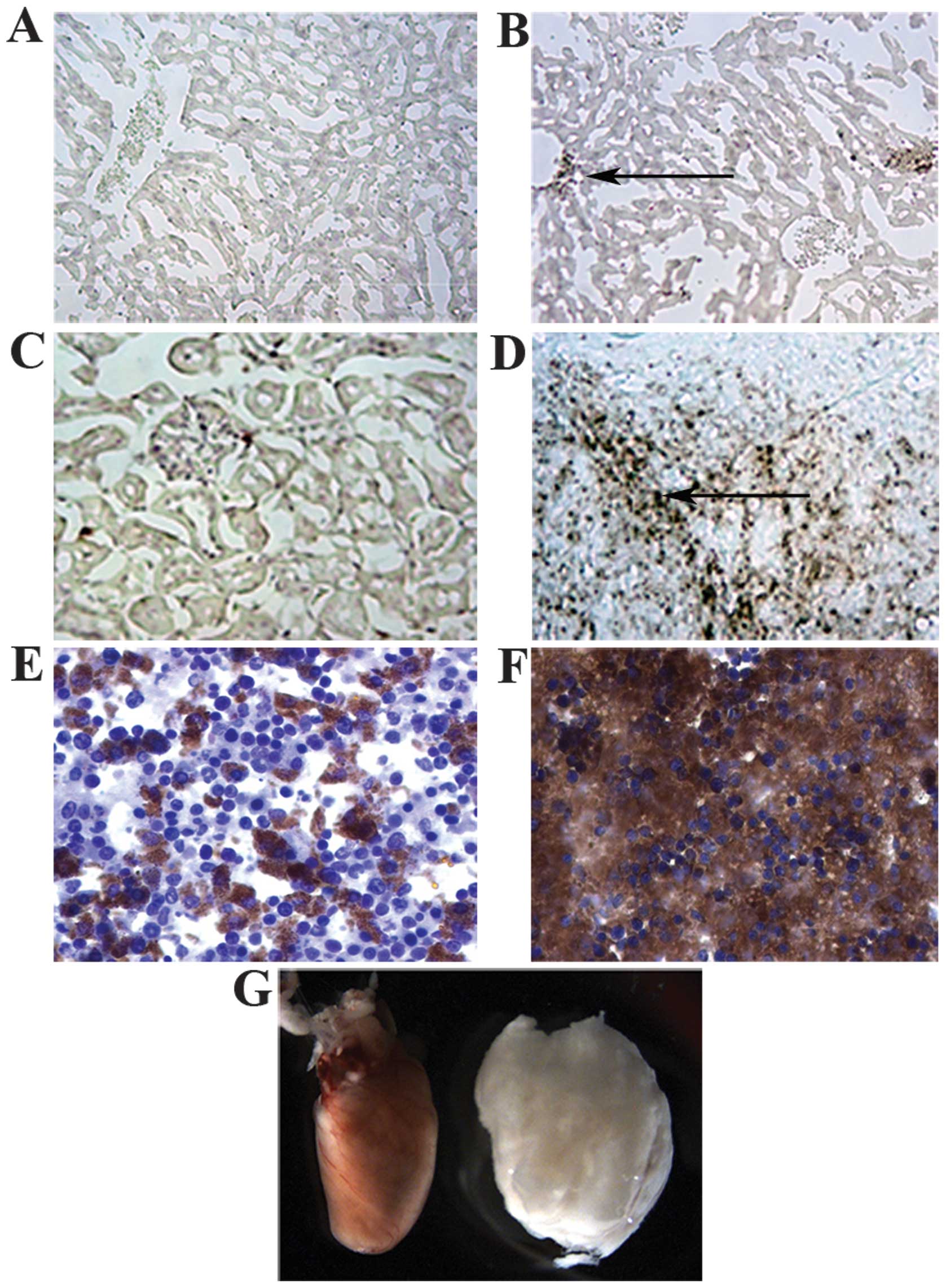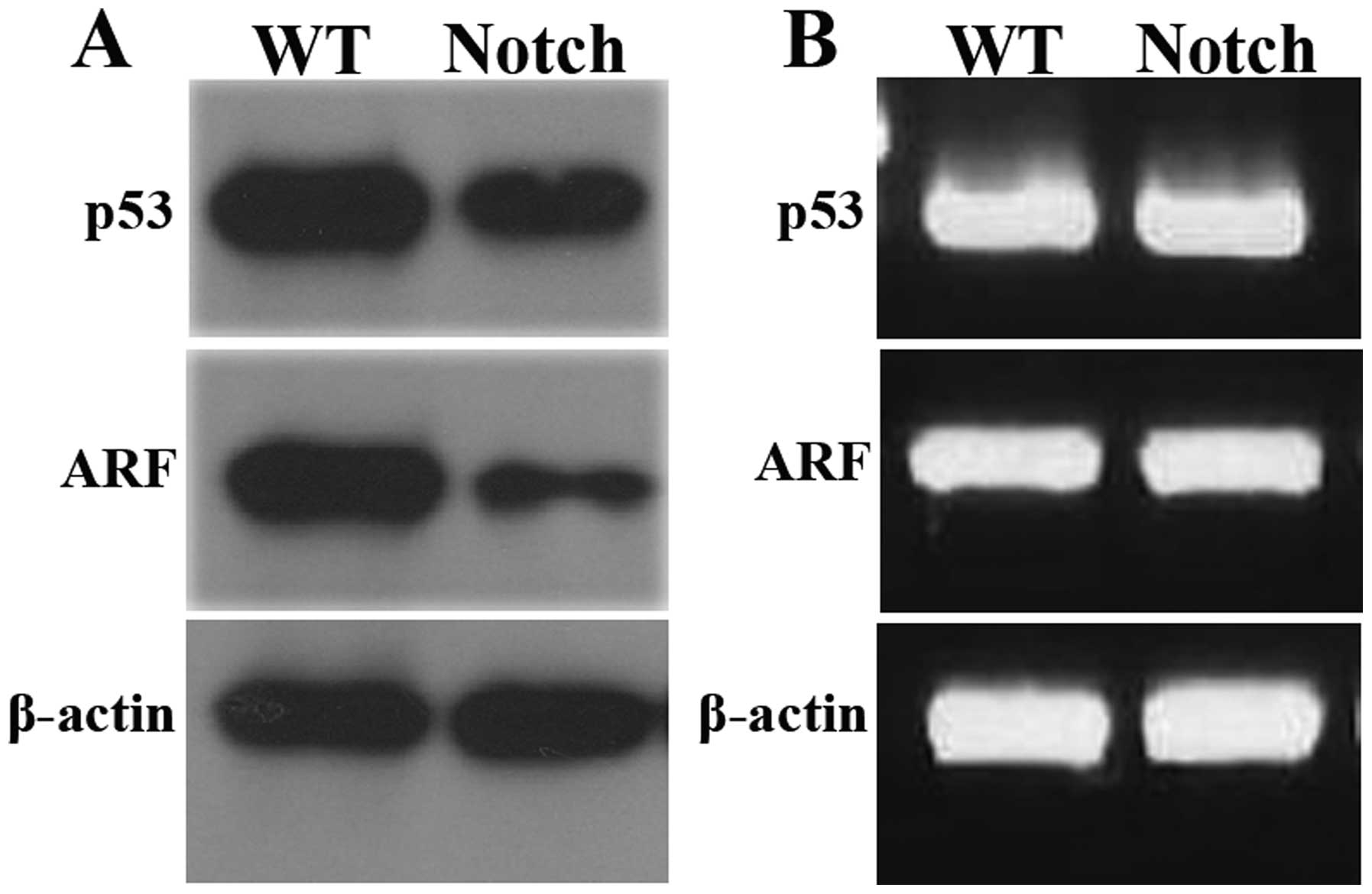|
1
|
Artavanis-Tsakonas S, Rand MD and Lake RJ:
Notch signaling: cell fate control and signal integration in
development. Science. 284:770–776. 1999. View Article : Google Scholar : PubMed/NCBI
|
|
2
|
Hansson EM, Lendahl U and Chapman G: Notch
signaling in development and disease. Semin Cancer Biol.
14:320–328. 2004. View Article : Google Scholar : PubMed/NCBI
|
|
3
|
Baron M: An overview of the Notch
signalling pathway. Semin Cell Dev Biol. 14:113–119. 2003.
View Article : Google Scholar
|
|
4
|
Radtke F, Wilson A, Stark G, et al:
Deficient T cell fate specification in mice with an induced
inactivation of Notch1. Immunity. 10:547–558. 1999. View Article : Google Scholar : PubMed/NCBI
|
|
5
|
Kumano K, Chiba S, Kunisato A, et al:
Notch1 but not Notch2 is essential for generating hematopoietic
stem cells from endothelial cells. Immunity. 18:699–711. 2003.
View Article : Google Scholar : PubMed/NCBI
|
|
6
|
Milner LA and Bigas A: Notch as a mediator
of cell fate determination in hematopoiesis: evidence and
speculation. Blood. 93:2431–2448. 1999.PubMed/NCBI
|
|
7
|
Schmitt TM and Zúñiga-Pflücker JC:
Induction of T cell development from hematopoietic progenitor cells
by delta-like-1 in vitro. Immunity. 17:749–756. 2002. View Article : Google Scholar : PubMed/NCBI
|
|
8
|
Robey E, Chang D, Itano A, et al: An
activated form of Notch influences the choice between CD4 and CD8 T
cell lineages. Cell. 87:483–492. 1996. View Article : Google Scholar : PubMed/NCBI
|
|
9
|
Politi K, Feirt N and Kitajewski J: Notch
in mammary gland development and breast cancer. Semin Cancer Biol.
14:341–347. 2004. View Article : Google Scholar : PubMed/NCBI
|
|
10
|
Ellisen LW, Bird J, West DC, et al: TAN-1,
the human homolog of the Drosophila notch gene, is broken by
chromosomal translocations in T lymphoblastic neoplasms. Cell.
66:649–661. 1991.PubMed/NCBI
|
|
11
|
Weng AP, Nam Y, Wolfe MS, et al: Growth
suppression of pre-T acute lymphoblastic leukemia cells by
inhibition of notch signaling. Mol Cell Biol. 23:655–664. 2003.
View Article : Google Scholar : PubMed/NCBI
|
|
12
|
Weng AP and Aster JC: Multiple niches for
Notch in cancer: context is everything. Curr Opin Genet Dev.
14:48–54. 2004. View Article : Google Scholar : PubMed/NCBI
|
|
13
|
Jundt F, Anagnostopoulos I, Förster R,
Mathas S, Stein H and Dörken B: Activated Notch1 signaling promotes
tumor cell proliferation and survival in Hodgkin and anaplastic
large cell lymphoma. Blood. 99:3398–3403. 2002. View Article : Google Scholar : PubMed/NCBI
|
|
14
|
Baumgärtner AK, Zettl A, Chott A, Ott G,
Müller-Hermelink HK and Starostik P: High frequency of genetic
aberrations in enteropathy-type T-cell lymphoma. Lab Invest.
83:1509–1516. 2003.PubMed/NCBI
|
|
15
|
Liu J and Lobe CG: Cre-conditional
expression of constitutively active Notch1 in transgenic mice.
Genesis. 45:259–265. 2007. View Article : Google Scholar : PubMed/NCBI
|
|
16
|
Holopainen T, Saharinen P, D’Amico G, et
al: Effects of angiopoietin-2-blocking antibody on endothelial
cell-cell junctions and lung metastasis. J Natl Cancer Inst.
104:461–475. 2012. View Article : Google Scholar : PubMed/NCBI
|
|
17
|
Chen L, Meng Q, Kao W and Xia Y: IκB
kinase β regulates epithelium migration during corneal wound
healing. PloS One. 6:e161322011.
|
|
18
|
Kisanuki YY, Hammer RE, Miyazaki J,
Williams SC, Richardson JA and Yanagisawa M: Tie2-Cre transgenic
mice: a new model for endothelial cell-lineage analysis in vivo.
Dev Biol. 230:230–242. 2001. View Article : Google Scholar : PubMed/NCBI
|
|
19
|
Uyttendaele H, Ho J, Rossant J and
Kitajewski J: Vascular patterning defects associated with
expression of activated Notch4 in embryonic endothelium. Proc Natl
Acad Sci USA. 98:5643–5648. 2001. View Article : Google Scholar : PubMed/NCBI
|
|
20
|
Puri MC and Bernstein A: Requirement for
the TIE family of receptor tyrosine kinases in adult but not fetal
hematopoiesis. Proc Natl Acad Sci USA. 100:12753–12758. 2003.
View Article : Google Scholar : PubMed/NCBI
|
|
21
|
Liu J, Deutsch U, Fung I and Lobe C:
Conditional and inducible transgene expression in endothelial and
hematopoietic cells using Cre/loxP and tetracycline-off systems.
Exp Ther Med. (In press).
|
|
22
|
Sarao R and Dumont DJ: Conditional
transgene expression in endothelial cells. Transgenic Res.
7:421–427. 1998. View Article : Google Scholar : PubMed/NCBI
|
|
23
|
Liu J, Yuan L, Molema G, et al: Vascular
bed-specific regulation of the von Willebrand factor promoter in
the heart and skeletal muscle. Blood. 117:342–351. 2011. View Article : Google Scholar
|
|
24
|
Liu J, Dong F, Jeong J, Masuda T and Lobe
CG: Constitutively active Notch1 signaling promotes
endothelial-mesenchymal transition in a conditional transgenic
mouse model. Int J Mol Med. 34:669–676. 2014.
|
|
25
|
Liu J, Deutsch U, Jeong J and Lobe CG:
Constitutive notch signaling in adult transgenic mice inhibits
bFGF-induced angiogenesis and blocks ovarian follicle development.
Genesis. May 10–2014.(Epub ahead of print).
|
|
26
|
Schroeder T and Just U: Notch signalling
via RBP-J promotes myeloid differentiation. EMBO J. 19:2558–2568.
2000. View Article : Google Scholar : PubMed/NCBI
|
|
27
|
Lam LT, Ronchini C, Norton J, Capobianco
AJ and Bresnick EH: Suppression of erythroid but not megakaryocytic
differentiation of human K562 erythroleukemic cells by notch-1. J
Biol Chem. 275:19676–19684. 2000. View Article : Google Scholar : PubMed/NCBI
|
|
28
|
Dai C and Gu W: p53 post-translational
modification: deregulated in tumorigenesis. Trends Mol Med.
16:528–536. 2010. View Article : Google Scholar : PubMed/NCBI
|
|
29
|
Bode AM and Dong Z: Post-translational
modification of p53 in tumorigenesis. Nat Rev Cancer. 4:793–805.
2004. View
Article : Google Scholar : PubMed/NCBI
|
|
30
|
Kubbutat MH, Jones SN and Vousden KH:
Regulation of p53 stability by Mdm2. Nature. 387:299–303. 1997.
View Article : Google Scholar : PubMed/NCBI
|
|
31
|
Zhang Y, Xiong Y and Yarbrough WG: ARF
promotes MDM2 degradation and stabilizes p53: ARF-INK4a locus
deletion impairs both the Rb and p53 tumor suppression pathways.
Cell. 92:725–734. 1998. View Article : Google Scholar : PubMed/NCBI
|
|
32
|
Kamijo T, Weber JD, Zambetti G, Zindy F,
Roussel MF and Sherr CJ: Functional and physical interactions of
the ARF tumor suppressor with p53 and Mdm2. Proc Natl Acad Sci USA.
95:8292–8297. 1998. View Article : Google Scholar : PubMed/NCBI
|
|
33
|
Radtke F, Wilson A, Mancini SJ and
MacDonald HR: Notch regulation of lymphocyte development and
function. Nat Immunol. 5:247–253. 2004. View Article : Google Scholar : PubMed/NCBI
|
|
34
|
Steinman RA: Cell cycle regulators and
hematopoiesis. Oncogene. 21:3403–3413. 2002. View Article : Google Scholar : PubMed/NCBI
|
|
35
|
Smith C: Hematopoietic stem cells and
hematopoiesis. Cancer Control. 10:9–16. 2003.PubMed/NCBI
|
|
36
|
Krebs LT, Xue Y, Norton CR, et al: Notch
signaling is essential for vascular morphogenesis in mice. Genes
Dev. 14:1343–1352. 2000.PubMed/NCBI
|
|
37
|
Limbourg FP, Takeshita K, Radtke F,
Bronson RT, Chin MT and Liao JK: Essential role of endothelial
Notch1 in angiogenesis. Circulation. 111:1826–1832. 2005.
View Article : Google Scholar : PubMed/NCBI
|
|
38
|
Zweidler-McKay PA and Pear WS: Notch and T
cell malignancy. Semin Cancer Biol. 14:329–340. 2004. View Article : Google Scholar
|
|
39
|
Pear WS, Aster JC, Scott ML, et al:
Exclusive development of T cell neoplasms in mice transplanted with
bone marrow expressing activated Notch alleles. J Exp Med.
183:2283–2291. 1996. View Article : Google Scholar : PubMed/NCBI
|
|
40
|
Washburn T, Schweighoffer E, Gridley T, et
al: Notch activity influences the alphabeta versus gammadelta T
cell lineage decision. Cell. 88:833–843. 1997. View Article : Google Scholar : PubMed/NCBI
|
|
41
|
Feldman BJ, Hampton T and Cleary ML: A
carboxy-terminal deletion mutant of Notch1 accelerates lymphoid
oncogenesis in E2A-PBX1 transgenic mice. Blood. 96:1906–1913.
2000.PubMed/NCBI
|
|
42
|
Gupta-Rossi N, Le Bail O, Gonen H, et al:
Functional interaction between SEL-10, an F-box protein, and the
nuclear form of activated Notch1 receptor. J Biol Chem.
276:34371–34378. 2001. View Article : Google Scholar : PubMed/NCBI
|
|
43
|
Oberg C, Li J, Pauley A, Wolf E, Gurney M
and Lendahl U: The Notch intracellular domain is ubiquitinated and
negatively regulated by the mammalian Sel-10 homolog. J Biol Chem.
276:35847–35853. 2001. View Article : Google Scholar : PubMed/NCBI
|
|
44
|
Campese AF, Bellavia D, Gulino A and
Screpanti I: Notch signalling at the crossroads of T cell
development and leukemogenesis. Semin Cell Dev Biol. 14:151–157.
2003. View Article : Google Scholar : PubMed/NCBI
|
|
45
|
Sherr CJ: The INK4a/ARF network in tumour
suppression. Nat Rev Mol Cell Biol. 2:731–737. 2001. View Article : Google Scholar : PubMed/NCBI
|
|
46
|
Eischen CM, Weber JD, Roussel MF, Sherr CJ
and Cleveland JL: Disruption of the ARF-Mdm2-p53 tumor suppressor
pathway in Myc-induced lymphomagenesis. Genes Dev. 13:2658–2669.
1999. View Article : Google Scholar : PubMed/NCBI
|
|
47
|
Beverly LJ, Felsher DW and Capobianco AJ:
Suppression of p53 by Notch in lymphomagenesis: implications for
initiation and regression. Cancer Res. 65:7159–7168. 2005.
View Article : Google Scholar : PubMed/NCBI
|
|
48
|
Nair P, Somasundaram K and Krishna S:
Activated Notch1 inhibits p53-induced apoptosis and sustains
transformation by human papillomavirus type 16 E6 and E7 oncogenes
through a PI3K-PKB/Akt-dependent pathway. J Virol. 77:7106–7112.
2003. View Article : Google Scholar : PubMed/NCBI
|
|
49
|
Reed SM, Hagen J, Tompkins VS, Thies K,
Quelle FW and Quelle DE: Nuclear interactor of ARF and Mdm2
regulates multiple pathways to activate p53. Cell Cycle.
13:1288–1298. 2014. View Article : Google Scholar : PubMed/NCBI
|













